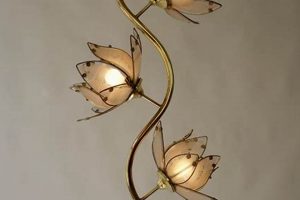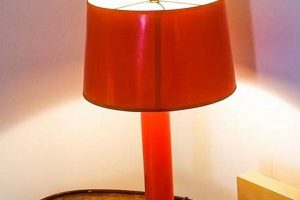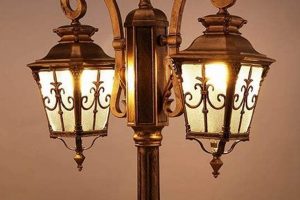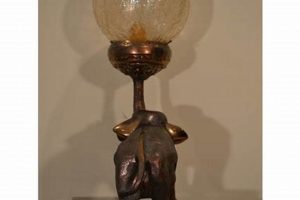Illuminating fixtures of a bygone era, these lighting solutions provide both functional and aesthetic value. Characterized by their upright design and often incorporating stylistic elements from specific periods such as Art Deco or Mid-Century Modern, they serve as focal points within interior spaces. For example, a torchiere lamp from the 1920s, featuring intricate metalwork and a frosted glass shade, exemplifies the elegance associated with these classic items.
The enduring appeal stems from their ability to blend practicality with decorative charm. They offer targeted illumination for reading or ambient lighting to enhance a room’s atmosphere. Furthermore, these pieces often represent historical design movements, providing insight into the aesthetics and craftsmanship of previous generations. Their acquisition and preservation contribute to the appreciation of design history and add character to contemporary homes.
The subsequent sections will delve into the specific types available, factors to consider when acquiring these items, and methods for maintaining their condition, ensuring that the allure of these timeless lighting fixtures continues to shine brightly.
Acquiring and Maintaining Vintage Stand Up Lamps
The following guidelines are intended to assist in the responsible acquisition and preservation of these items, ensuring their continued functionality and aesthetic value.
Tip 1: Assess Condition Thoroughly: Prior to purchase, a careful examination is essential. Inspect the lamp for structural integrity, including the base, stem, and shade supports. Look for signs of rust, corrosion, or damage to electrical components. Functionality should be verified before purchase, if possible.
Tip 2: Verify Authenticity: Research the manufacturer or designer markings to confirm the item’s era and authenticity. Consult with experts or compare the lamp to documented examples in reputable resources to avoid reproductions marketed as original pieces. Patent numbers or manufacturer stamps are often indicators of age and provenance.
Tip 3: Evaluate Electrical Wiring: Original wiring in these pieces is often outdated and potentially unsafe. Replacement of wiring with modern, UL-listed components is highly recommended to mitigate fire hazards and ensure safe operation. Consider professional rewiring to maintain historical accuracy while adhering to current safety standards.
Tip 4: Consider Shade Condition and Availability: Shades, particularly those made of fabric or glass, are susceptible to damage. Assess the condition of the shade carefully. Replacements for vintage shades can be difficult to source. When cleaning fabric shades, use gentle methods such as vacuuming with a soft brush attachment or spot cleaning with a mild detergent.
Tip 5: Implement Proper Cleaning Procedures: Regular cleaning is important for preventing the accumulation of dust and grime. Use a soft, dry cloth to dust the lamp’s surfaces. For metal components, consider a specialized metal cleaner appropriate for the specific material (e.g., brass, chrome). Avoid abrasive cleaners that could damage the finish.
Tip 6: Store Lamps Safely: When not in use, these fixtures should be stored in a dry, climate-controlled environment to prevent deterioration. Wrap the lamp in protective material, such as acid-free tissue paper or bubble wrap, to guard against scratches or damage during storage.
Tip 7: Document the Lamp’s History: If possible, research and document the lamp’s history, including its provenance, previous owners, and any significant repairs or alterations. This information enhances the lamp’s value and provides context for future owners.
By adhering to these guidelines, collectors and enthusiasts can ensure the longevity and beauty of their investments. Proper care not only preserves the historical significance of these items but also ensures their safe and continued use for years to come.
The following sections provide details on finding and repairing “vintage stand up lamps”.
1. Design Aesthetics
The design aesthetics of vintage stand up lamps are intrinsically linked to their historical and cultural significance. These lamps are not merely functional objects; they are artifacts that reflect the stylistic preferences and technological capabilities of their respective eras. The form, materials, and decorative elements employed in their construction provide insight into the artistic movements and societal values prevalent during their creation. For instance, the streamlined silhouettes and geometric motifs characteristic of Art Deco lamps epitomize the era’s fascination with modernity and industrial progress. Conversely, the organic forms and handcrafted details found in Arts and Crafts lamps exemplify a rejection of mass production and an emphasis on artisanal skill.
The aesthetic appeal of these lamps significantly impacts their value and desirability in the collector’s market. Lamps with distinctive designs or those representing iconic design movements often command higher prices. The presence of unique decorative elements, such as hand-painted glass shades or intricate metalwork, further enhances their aesthetic and monetary worth. Understanding the design principles associated with different historical periods allows collectors and enthusiasts to appreciate the artistic merit and historical context of these items. Furthermore, awareness of design aesthetics informs restoration efforts, ensuring that repairs and replacements are sympathetic to the original style and intention of the lamp’s creator.
The preservation of these lamps original design aesthetics is crucial for maintaining their historical integrity and cultural relevance. Collectors and restorers face the challenge of balancing the need for functional repairs with the desire to preserve the lamp’s original appearance. The application of appropriate cleaning methods and restoration techniques is essential for preventing damage to delicate finishes and decorative elements. By carefully considering the design aesthetics of each lamp, it is possible to safeguard its historical significance and ensure its continued appreciation by future generations.
2. Historical Period
The historical period during which a vintage stand up lamp was manufactured significantly influences its value, design, and collectibility. Understanding the historical context is crucial for accurate identification, appreciation, and responsible restoration.
- Art Deco Era (1920s-1930s)
Lamps from this period often feature geometric shapes, luxurious materials such as chrome and glass, and a sense of streamlined elegance. Examples include torchiere lamps with stepped bases and skyscraper-inspired designs. The prevalence of Art Deco lamps reflects the era’s embrace of modernity and technological progress, influencing interior design and lighting trends.
- Mid-Century Modern (1940s-1960s)
This period saw the introduction of minimalist designs, organic shapes, and the use of new materials like plastic and fiberglass. Lamps often feature slender profiles, asymmetrical forms, and a focus on functionality. Examples include tripod lamps with conical shades and adjustable arms. The Mid-Century Modern aesthetic reflected a post-war optimism and a desire for innovative, practical designs.
- Victorian Era (1837-1901)
Victorian lamps are characterized by ornate details, heavy embellishments, and the use of materials such as brass, cast iron, and stained glass. Examples include floor lamps with decorative bases, fabric shades adorned with fringe, and intricate floral motifs. These lamps reflected the Victorian era’s emphasis on opulence, craftsmanship, and sentimental ornamentation.
- Arts and Crafts Movement (1880-1920)
These lamps emphasize handcrafted elements, natural materials, and a rejection of mass production. Examples include lamps with copper or mica shades, simple geometric forms, and a focus on functionality. The Arts and Crafts movement reflected a desire for authenticity, craftsmanship, and a return to simpler, more naturalistic designs.
The historical period of a stand up lamp is a defining characteristic that informs its design, materials, and cultural significance. Identifying the correct era allows for appropriate restoration techniques, accurate valuation, and a deeper appreciation of the lamp’s place in design history. Considering the lamp’s historical period is essential for collectors and enthusiasts seeking to acquire, preserve, and understand these illuminating artifacts.
3. Material Composition
The material composition of vintage stand up lamps directly affects their durability, aesthetic appeal, and historical accuracy. The selection of materials during a specific period often reflected technological advancements, economic conditions, and prevailing design philosophies. Consequently, identifying the materials used in a lamp’s construction is crucial for determining its authenticity and for implementing appropriate restoration techniques. For example, the presence of Bakelite, a type of early plastic, suggests a manufacturing date within the Art Deco or early Mid-Century Modern periods. Similarly, the use of specific types of brass or copper alloys can provide insights into the lamp’s origin and manufacturing process.
The choice of materials also dictates the appropriate methods for cleaning and preserving these items. A brass lamp with an intact patina requires different cleaning and polishing techniques than a chrome-plated lamp from the same era. Inappropriate cleaning agents or methods can irreparably damage the finish, reducing the lamp’s value and detracting from its historical character. Furthermore, the availability of replacement parts often depends on the original materials used in the lamp’s construction. Sourcing period-correct glass shades or hardware may necessitate consulting specialized suppliers or utilizing custom fabrication techniques. Understanding the material composition enables informed decisions regarding repair and restoration, ensuring the lamp’s longevity and preserving its original appearance.
In summary, the materials used in the construction of vintage stand up lamps are integral to their identification, preservation, and value. Analyzing the material composition provides insights into the lamp’s historical context, informs appropriate conservation strategies, and guides the sourcing of replacement parts. A comprehensive understanding of these materials is essential for collectors, restorers, and anyone seeking to appreciate the historical and aesthetic significance of these illuminating artifacts.
4. Functionality
The primary purpose of any lamp, including vintage stand up lamps, is to provide illumination. However, functionality extends beyond merely producing light. It encompasses the lamp’s ability to effectively and safely illuminate a space, its adjustability to suit different tasks or preferences, and its integration with the electrical grid. A vintage lamp lacking functional efficacy, despite its aesthetic appeal, diminishes in value and practicality. For instance, a floor lamp with a corroded socket or frayed wiring poses a safety hazard and cannot fulfill its intended purpose until repaired. Similarly, a lamp with a shade that diffuses light poorly may be aesthetically pleasing but provides inadequate illumination for reading or other focused activities.
The functionality of these pieces is also intertwined with their design. Lamps designed for reading, such as those with adjustable arms or focused spotlights, prioritize task lighting. Conversely, torchiere lamps, intended for ambient illumination, distribute light upwards, creating a softer, more diffused effect. Understanding the intended functionality of a particular lamp is essential for its proper placement and use within a space. Restoring these lamps often requires addressing functional shortcomings, such as replacing outdated wiring with modern equivalents or repairing damaged sockets. This ensures both safety and optimal performance, preserving the lamp’s practical value.
Ultimately, the assessment of a vintage stand up lamp must include a thorough evaluation of its functionality. While aesthetic considerations are important, a non-functional or unsafe lamp is fundamentally flawed. The integration of form and function is paramount. This understanding guides restoration efforts, informs acquisition decisions, and ensures the continued utility of these historic lighting fixtures. By prioritizing functionality alongside aesthetic appeal, these lamps continue to serve as both illuminating devices and enduring symbols of design history.
5. Rarity
The rarity of a vintage stand up lamp significantly influences its collectibility and market value. Scarcity stems from several factors, including limited production runs, unique design features, or historical circumstances that restricted their initial distribution. A lamp manufactured for only a brief period, or one produced by a lesser-known artisan, often commands a premium due to its inherent scarcity. For example, a Tiffany Studios floor lamp with a rare “Wisteria” shade, produced in limited quantities due to its complex construction, exemplifies how rarity elevates an item’s worth. Understanding the elements that contribute to a lamp’s limited availability is crucial for discerning collectors and appraisers.
The impact of rarity extends beyond mere monetary value. It also underscores the historical significance of these pieces. A lamp associated with a specific historical event or cultural movement, and whose production was subsequently curtailed, serves as a tangible link to the past. Consider, for instance, lamps crafted during the Bauhaus movement. The limited output of these pieces, coupled with their association with a groundbreaking design philosophy, renders them highly sought after. Rarity, in this context, transforms a functional object into a historical artifact, providing insight into the aesthetic and social values of a particular era. Verifying the authenticity and provenance of rare lamps requires meticulous research and expert appraisal, further emphasizing the importance of understanding this aspect.
In conclusion, the rarity of vintage stand up lamps is a critical determinant of their desirability and value. It is a multifaceted attribute influenced by production numbers, design uniqueness, and historical context. Recognizing and appreciating the factors contributing to scarcity enables collectors to make informed acquisitions, preserve significant artifacts, and understand the historical narratives embedded within these illuminating objects. Ignoring the element of rarity is to overlook a fundamental aspect of the antique lighting market, potentially leading to misinformed valuations or missed opportunities for acquiring historically significant pieces.
6. Restoration
Restoration, in the context of vintage stand up lamps, encompasses the process of returning a lamp to its original condition or functionality. This undertaking necessitates careful consideration of historical accuracy, material compatibility, and ethical preservation practices, ensuring the lamp’s longevity and historical integrity.
- Electrical Rewiring and Safety
Outdated wiring in vintage lamps poses a significant safety hazard. Restoration often involves replacing original wiring with modern, UL-listed components. The objective is to maintain the lamp’s aesthetic while adhering to current safety standards. Example: Replacing brittle, cloth-covered wiring with new, insulated wiring that matches the original gauge and color. Implications include enhanced safety and compliance with electrical codes.
- Surface Cleaning and Refinishing
Years of accumulated dirt, grime, and oxidation can obscure the original beauty of a lamp’s surface. Gentle cleaning methods appropriate for the material (e.g., brass, chrome, wood) are crucial. Refinishing, when necessary, should be done with products that replicate the original finish and avoid damaging the underlying material. Example: Removing oxidation from a brass lamp using a specialized brass cleaner and polishing with a soft cloth. Implications include restored aesthetic appeal and prevention of further corrosion.
- Shade Repair and Replacement
Lamp shades, particularly those made of fabric or glass, are susceptible to damage. Restoration may involve repairing tears or stains in fabric shades or replacing broken glass panels. Sourcing period-correct replacement shades can be challenging but is essential for maintaining the lamp’s historical accuracy. Example: Replacing a torn silk shade with a replica made using similar materials and construction techniques. Implications include restored functionality and adherence to the lamp’s original design intent.
- Structural Repair and Stabilization
Loose joints, cracked bases, and damaged supports compromise the structural integrity of a lamp. Restoration often involves repairing or replacing damaged components, ensuring the lamp is stable and safe to use. Example: Re-soldering a loose joint in a brass lamp base to prevent wobbling. Implications include improved stability and prevention of further structural damage.
The nuances of each lamp need to be considered when undertaking restoration to preserve the value and history. Understanding these factors is essential for collectors, restorers, and enthusiasts seeking to preserve the historical significance and functionality of these illuminating artifacts. A careful balance between preservation and functionality should guide every restoration decision.
Frequently Asked Questions
The following addresses common inquiries regarding the acquisition, care, and identification of these lighting fixtures.
Question 1: How does one determine the approximate age of a lamp with no visible markings?
The absence of markings necessitates a comprehensive assessment of design characteristics, materials used, and construction techniques. Researching stylistic trends associated with specific historical periods can provide clues. Consulting with antique lighting specialists may also prove beneficial in determining the approximate age.
Question 2: What are the potential dangers of using a vintage lamp with its original wiring?
Original wiring in older lamps is often deteriorated, posing a significant risk of electrical shock or fire. Insulation may be cracked or frayed, exposing live wires. Replacement with modern, UL-listed wiring is strongly recommended to mitigate these hazards.
Question 3: Is it advisable to polish a vintage brass lamp to restore its original shine?
Polishing may remove the patina, a layer of oxidation that develops over time and contributes to the lamp’s historical character. A gentle cleaning with a specialized brass cleaner is often preferable to retain the patina while removing surface dirt.
Question 4: What is the best method for cleaning a vintage fabric lamp shade?
Vacuuming with a soft brush attachment is generally the safest method for removing dust from fabric shades. Spot cleaning with a mild detergent may be necessary for stains, but testing the detergent on an inconspicuous area is recommended to prevent discoloration.
Question 5: Where can period-correct replacement parts for vintage lamps be sourced?
Specialized antique lighting suppliers, online marketplaces, and architectural salvage yards are potential sources for period-correct replacement parts. Consulting with restoration professionals may also provide access to rare or hard-to-find components.
Question 6: How does one properly store a vintage lamp when not in use to prevent damage?
Storing lamps in a dry, climate-controlled environment is crucial to prevent deterioration. Wrapping the lamp in protective material, such as acid-free tissue paper or bubble wrap, guards against scratches and other physical damage.
Acquiring and maintaining these classic lighting fixtures requires careful assessment and research.
For further insight, the following section details notable vintage stand up lamp collections.
Conclusion
This exploration has illuminated key aspects of vintage stand up lamps, from their historical significance and design aesthetics to their functional restoration and the impact of rarity on their collectibility. The analysis underscores the importance of understanding the materials, manufacturing techniques, and historical context when acquiring or preserving these illuminating artifacts. Careful attention to safety considerations, particularly regarding electrical components, is paramount.
The enduring appeal stems not only from their functional utility but also from their capacity to embody design trends and cultural values of past eras. Continued research, responsible restoration, and informed collecting practices will ensure that these sources of light and design history remain appreciated for generations to come. This effort contributes to a broader understanding of design evolution and the preservation of tangible cultural heritage.







